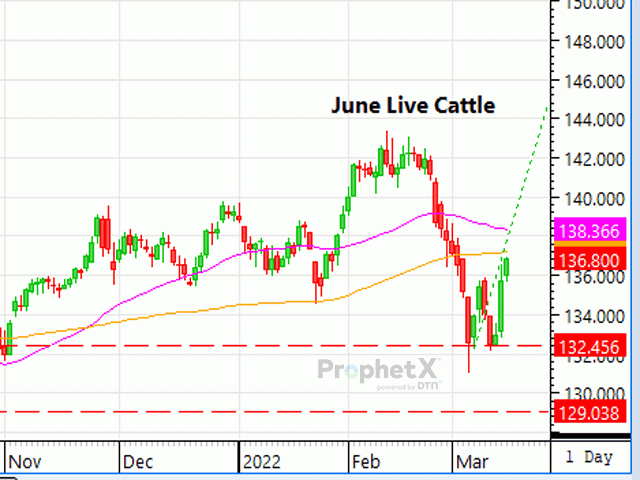Call the Market
Cattlemen Should Look at Market Fundamentals to Understand Current Situation
Whenever something new hits the market, you can almost guarantee nine times out of 10, the cattle market is going to react negatively. But as the war in Ukraine becomes less of a breaking news headline and more of a constant reality, the cattle market could look to its fundamentals for direction.
Monday's (March 14) trade was significant for the live cattle complex. March 11's market showed modest signs of support at $132.40, but it was up to Monday's market whether the complex was going to ignore the support and erode to weaker prices, chop sideways or springboard back to more realistic prices for the market's current scenario. And higher the market went! By Monday's end, April live cattle closed $3.02 higher at $140.32, June live cattle closed $2.75 higher at $135.70 and August live cattle closed $1.60 higher at $136.67. As the week has continued to trade, cattlemen are reevaluating market fundamentals and noting some key significances.
Let's look at the positive and negative signs.
POSITIVE SIGNS:
First, while it's annoying that the live cattle complex reacts oppositely to the grain market, the recent surge from Russia's invasion should already be accounted for in the grain markets. That being said, daily grain movements will likely influence the live cattle market and could hinder its ability to make a day's move higher, But by and large, the market most likely won't see another catastrophic blow like it did upon the first news of war any time soon.
P[L1] D[0x0] M[300x250] OOP[F] ADUNIT[] T[]
Second, boxed beef prices are finally showing signs that a bottom has been found. For three consecutive trading days, afternoon boxed beef prices have closed higher. This many seem counterintuitive because once again consumers are going to see higher meat prices amid unbridled inflation. But higher boxed beef prices help boost packer profits, which could in return mean they're willing to budge in the cash cattle market.
Third, a bottom in boxed beef prices also means an uptick in packer margins. While I fully understand most producers loathe packers, even their bottom line plays a role in the market's grand scheme. If packers are seeing higher returns from beef cuts, they may grow more active in the cash cattle market while supplies of market-ready cattle are low.
WORRISOME SIGNS:
First, time is of the essence. With only six more weeks before May 1, the market has very little time to claw its way back in the cash cattle area before supplies become plentiful for packers. We've known that come May/June, supplies of market-ready cattle are going to be ample and cash prices are likely going to weaken as packers have thousands of cattle available at their disposal.
Second, throughput could be compromised in the weeks ahead as packers plan dark days for cooler cleaning. Isn't it ironic that when supplies of market-ready cattle are thin, packers "need" to clean their coolers? Last week's slaughter was estimated at 644,000 head -- 10,000 head fewer than the week before and 5,000 head fewer than a year ago. As packers appraise the market's scenario, they see supplies of cattle are on the cusp of being at their disposal and they only need to get by in the cash market until then.
In conclusion, the futures market plummeted upon the announcement of war, but as cattlemen look to regain some confidence in the market, they will likely look to its fundamentals for understanding.
ShayLe Stewart can be reached at ShayLe.Stewart@dtn.com
(c) Copyright 2022 DTN, LLC. All rights reserved.




